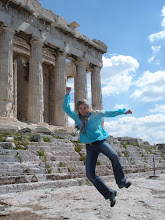









The Museum of Gold of the National Bank of the Republic of Colombia has an amazing display of gold and precious objects from days past when Colombia had not yet been found by Europeans. Indigenous peoples of this area where in many great ways similar but also in other smaller ways, different. Their ideas about the world, their foods, their political and spiritual systems seem to have overlapped in many ways. From what I learned at the museum, these people believed in nature, in cycles that ruled everything and in different dimensions and opposites that complemented each other like day/night, male/female, land/sky, etc. Animals were the medium that were able to supercede the border between life on earth and the afterlife, because many of them were able to travel between the dimensions (for example, some could walk on earth and fly in the sky like birds, and walk on earth and swim in the water like frogs and snakes). The spiritual leaders, the shamans, were the mediums as well to use animals to communicate with the underworld or the spiritual world and often depicted themselves as animals such as jaguars, frogs, lizards, bats, birds, fish, etc. They made gold (or a mixture of gold with other metals like copper) figures of these animals and offered them to their deities in nature and also put them in the tombs of the dead. The political leaders, or caciques, had more earthly powers and dealt with life on earth.
The sun was seen as the God of everything and its tears and sweat were the gold that was found on earth. So gold was not seen as an economic element, but a spiritual one. Gold was used to make objects to offer and also was made into jewelry for all people to wear. For example, all people wore nose rings, earrings (often huge plugs), bracelets, necklaces or chest plates, shin plates, belts, etc. Some of the nose rings are almost one foot in length or are huge pieces that cover half the face and even the neck. This idea of covering the face was to remove the humanness and give the idea of another being. It seems like more the shamans and the caciques used the bigger pieces of gold jewelry and the lay people used less extravagant pieces. The objects they made of gold, were first molded from beeswax, hardened, covered in a clay mold…then the beeswax was melted out of the mold and gold or gold/copper mixtures were poured in and hardened, then the clay mold, broken. They made amazingly intricate and huge pieces of different animals and with many different designs and then would offer them to the Gods (like throwing them into sacred lakes), put them in underground tombs, or hide them in different places. Also, the shamans would sacrifice humans to the sun god by letting the sun “eat” them…or basically leaving them in the sun until they died from excessive sun exposure. Wow!
They would also use hallucinogenic plants to communicate with their gods, like yopo or yajé. Yopo was a tree bark that was ground up into a powder and sniffed. Yagé was a plant that was boiled into a tea. Yagé makes one lose control over their sphincters and requires one to be babysat. It is a multi-day experience. It is possible to even find today in Colombia…people go to a farm and do it under the watch of an indigenous person (shaman so they say). Coca was chewed by the shamans, who were only male in most cultures, as a spiritual way to communicate with and offer to the gods. They used limestone powder as a helping agent to release certain alkaloids in the coca when they chewed it. This powder was carried in a poporo, a gold container also symbolizing the female vagina, and a gold stick, symbolizing the male penis, was used to extract the powder. It was all very symbolic. Clearly then, women were not allowed to chew coca.
This place is one of the most amazing museums I have ever been to!
